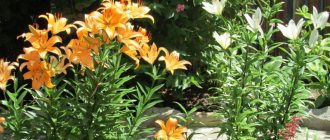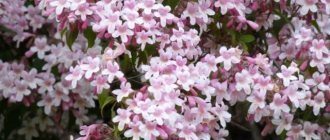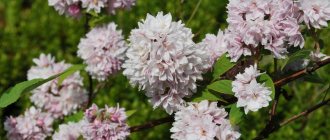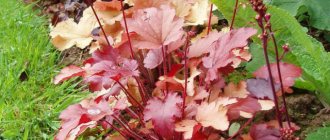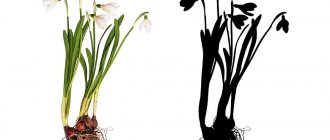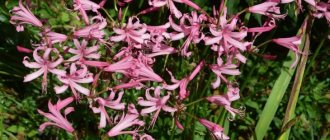A plant with a strange name, mountain ash, is a valuable ornamental shrub that is found in nature mainly in Asia. But, thanks to its attractive appearance, abundance of varieties and ease of care, this crop has been grown in open ground conditions all over the world since the 18th century.
In today's article we will not only take a detailed look at the botanical features of this crop, but also provide valuable recommendations for the use of fieldfare in landscape design and pay attention to its planting and cultivation.
What is rowan-leaved fieldfare?
The Latin name of the mountain ash shrub sounds like sorbaria. This term, in turn, comes from the word “sorbus”, which means “rowan” in Latin. Indeed, if you carefully examine the leaves of the plant, you will notice a resemblance to a rowan tree.
Despite the fact that the rowan plant belongs to the Rosaceae family, even its flowering is somewhat reminiscent of mountain ash. The only difference is the season of blooming of the buds and their shape. Rowan is covered with lush corymbose inflorescences in the spring, and the ornamental mountain ash shrub is covered in autumn, and the small flowers themselves are collected in small panicles. In addition, they have long stamens with anthers, which is why they look very fluffy (Figure 1).
Figure 1. Ornamental shrub belongs to the Rosaceae family
In total, the genus of fieldfare has 10 varieties, and in nature they are all found in Asia. Many of them are capable of growing up to 6 meters in height, but those varieties that are commonly used in gardening and landscape design rarely exceed the 3 meter mark.
What does fieldfare go with?
Fieldfare can become the most expressive element of the garden if you place suitable companion plants in close proximity to it.
Thus, ground cover and low-growing plants of bright colors can highlight the exquisite beauty of the shrub:
- dahlias;
- viola;
- tulips;
- sedums;
- Heuchera;
- hosts;
- bergenia.
The snow-white inflorescences of the mountain ash tree stand out against the background of various coniferous plants, such as thuja, pine, juniper or spruce. This crop also combines advantageously with other ornamental shrubs, the flowers of which are characterized by a bright color. Among them are:
- lilac;
- spirea;
- scumpia;
- jasmine;
- vesicular carp.
Advice! If you use fieldfare in combination with white-flowered shrubs and dwarf fruit trees, you can create a fantastically spectacular white garden.
An interesting result can be achieved by planting different types of fieldfare in the same area of the garden, whose flowering dates do not coincide. This will allow you to admire unusually beautiful flowers throughout the season.
Botanical description of the plant
If you want to grow fieldfare on your site, you need to familiarize yourself with the botanical description of the plant and its characteristics (Figure 2).
Culture has the following characteristics:
- It is a deciduous evergreen shrub and can grow up to 3.5 meters in height. Taller varieties are not used in landscape design.
- The root system is powerful and branched. Thanks to this, the size of the shrub quickly increases due to numerous young shoots.
- The flowers are small but numerous, usually white or cream in color. They are very well pollinated by insects.
- The decorative value of a crop is determined not only by its flowering, but also by the unusual color of the leaves. For example, when the crown just begins to become covered with leaves, the plates are colored pink-orange, become light green in the summer, and bright red in the fall.
Figure 2. Due to the lush inflorescences and unusually colored leaves, the crop is beautiful at any time of the year.
Due to its unpretentiousness and fairly large crown diameter, fieldfare is often used for group and single plantings, creating hedges, decorating the banks of artificial reservoirs and strengthening slopes. However, it should be borne in mind that without formative pruning, a shrub can reach very impressive sizes.
Types and varieties
Only four species of fieldfare can be found in cultivation.
Fieldfare (Sorbaria tomentosa)
Shrub up to 6 m high from East Asia. It grows mainly on mountain slopes, does not bloom and does not tolerate cold well.
Fieldfare (Sorbaria arborea)
It comes from the same region and reaches the same height. This species blooms from July to August, is frost-resistant, but grows very slowly.
Pallas's Fieldfare (Sorbaria pallasii)
A species found on the rocky slopes of the Far East and Transbaikalia. This is a very beautiful shrub up to 120 cm high. The young shoots of this fieldfare are brown in color, bare or finely pubescent with yellowish branched hairs; on older shoots the bark peels off. The leaves are unpaired-pinnate, usually pubescent with red hairs, linear-lanceolate, up to 15 cm long.
The flowers are creamy or white, up to 15 mm in diameter, collected in small apical panicles. The fruits of Pallas's fieldfare are pubescent leaflets. The plant is frost-resistant.
Fieldfare (Sorbaria sorbifolia)
The most popular cultivated species, in nature it forms thickets on the edges of forests and along the banks of rivers in Siberia, the Far East, China, Korea and Japan. This plant is up to 2 m high with gray-brown straight shoots and odd-pinnate, sharply serrated leaves up to 20 cm long with a pointed tip. When they bloom, the leaves have a pinkish-orange hue, in summer they are light green, and in autumn the foliage turns yellow or carmine red.
The creamy, fragrant flowers of the mountain ash are collected in pyramidal paniculate inflorescences up to 30 cm long. Because of the long stamens, the inflorescences appear fluffy. The fruits of the mountain ash are pitcher-shaped fused leaflets.
The highly decorative fieldfare Sam deserves special attention - a compact plant up to 120 cm high with a rounded crown, greenish-yellow shoots and leaves with a reddish or copper tint. White flowers are collected in paniculate inflorescences. To preserve the color of the leaves, this variety requires brighter lighting than for the original appearance.
Fieldfare in landscape design
The active use of mountain ash in landscape design is explained by the numerous advantages of the culture. It has an attractive appearance, does not require special care and is characterized by abundant and long-lasting flowering (Figure 3).
Note: In addition, the shrub reproduces easily and serves as an excellent honey plant, which is also highly valued by gardeners.
As a rule, the plant is used as a single bright accent for the garden. It can also be placed on the lawn in group and single plantings. However, when planning a group planting, it is necessary to take into account the active growth of shoots, which can shade other ornamental plants.
Fieldfare is also prone to active development of root shoots. To prevent young roots from interfering with the development of other crops, a protective ring is dug around the fieldfare. It will stop the growth of shoots, since most of the plant's roots are close to the surface.
Figure 3. The plant is used both in single plantings and to create hedges
Many people choose fieldfare to create a hedge. This really makes sense, since the crop tolerates cutting very well and grows quickly, so the hedge can be given almost any shape.
Full description of fieldfare
Mountain ash (Sorbaria sorbifolia) is a beautiful shrub with a spreading crown and lush white flowers. Undemanding to care, takes root on different soils. Long-lasting: on average lives up to 50 years.
What does fieldfare look like?
This is a tall deciduous shrub with erect, strong shoots of small thickness (up to 1.5 cm). The surface of the branches is smooth, sometimes with slight pubescence. The flowers are white with a yellowish tint, collected in lush panicle inflorescences. They are distinguished by their porous structure and pleasant aroma.
Flowers appear only on this year's shoots, so any pruning can be done, even radical. Flowering duration is 2–3 weeks, sometimes up to 1 month. Period: second half of June – beginning of July. Inflorescences in young fieldfare bushes form at two or three years of age.
The leaves have a characteristic lanceolate shape, reminiscent of rowan, which is why the name of the plant is associated. The sizes are very large, reaching 20–25 cm in length. The color is attractive, light green. In September they begin to turn yellow, and in early October they begin to turn red.
Fieldfare is decorative thanks to its interesting leaves and large white inflorescences
How quickly does the fieldfare bush grow?
The rowan-leaved shrub is undemanding to care and grows quite quickly. With normal care, the annual increase is:
- 40 cm wide;
- 30 cm in height.
The mountain ash reaches its maximum height and width by the age of 10 years.
Dimensions and height of the fieldfare bush
The height of the mountain ash is 2–3 m. A characteristic feature is a spreading crown (up to 4 m in adult specimens). Thanks to this, the plant is used in single plantings to decorate the garden. When planting, you should leave a gap between neighboring plants, and also maintain a distance to the nearest building of at least 2 m.
Planting seedlings and care
Planting and caring for fieldfare is not particularly difficult, since this crop quickly adapts to new climatic and soil growing conditions. But in order to get a beautiful spreading bush, you need to know exactly how to plant fieldfare and take into account some features of its further care (Figure 5).
First let's look at the landing:
- For planting, pre-purchased seedlings are usually used. Growing seedlings on your own usually does not bring success.
- It is imperative to remove all dry and damaged branches from seedlings, otherwise after planting the plant will begin to spend energy not on rooting, but on restoring damaged above-ground parts. The remaining shoots should also be shortened to 15 cm, leaving 2-4 buds on each.
- A few hours before planting, the roots are immersed in water so that they are saturated with moisture.
- The shrub can be placed in both sunny and shaded areas. The degree of soil fertility is also not particularly important, but the crop develops best on loam with neutral acidity.
- It is best to start planting in early spring. Young plants do not need additional insulation, as they can easily tolerate even severe frosts.
The planting hole for fieldfare should not be deep, but it must be made wide, since the root system quickly grows to the sides. Typically the depth of the hole is 40 cm and the width is 80 cm.
Figure 5. Young seedlings need abundant watering
The pit must be filled with an earthen mixture consisting of humus, sand and turf soil in a ratio of 2:1:1. The soil is poured so that it forms a mound. A seedling is placed in its center, the roots are straightened and completely covered with soil at the same level as the ground. After this, the plant is watered, and the tree trunk circle is mulched with peat to stop the evaporation of moisture.
Planting a plant in open ground - how to proceed?
In open ground, decorative fieldfare is grown from the beginning of spring until the first sap formation, less often in the autumn after the main leaf fall. This plant is quite shade-tolerant, so it is often placed in areas under large trees (aspen, birch, alder, etc.) in well-enriched and nutritious soil.
It grows well on sandy and clayey soils and also tolerates close proximity to groundwater. It takes root worse in soil that is too acidic and depleted. For planting, dig a hole no more than 1.5 meters deep and 75 by 75 centimeters in diameter or slightly less. If a group is planted, then between each of the individual seedlings there is a distance of at least 1 meter.
Since fieldfare, regardless of the variety, is a fast-growing shrub, it, like thorns, tends to grow uncontrollably, so before planting the seedlings, the walls of the dug hole are lined with dense material, for example, slate or metal sheets.
At the very bottom of the pit, first place a layer of drainage made of expanded clay, small crushed stone or broken brick, then - the remains of turf soil, which are pre-mixed with fresh compost and humus.
From above, the rhizomes of the finished sprout are carefully immersed in the soil and filled to the limit with the remaining amount of soil mixed with organic fertilizers, mullein or bird droppings.
After planting the seedling, its root collar should be 2-3 centimeters above the ground surface. Then immediately pour in 2 buckets of warm settled or rainwater, and when it is completely absorbed, begin mulching the planting area with suitable material.
Watering and fertilizing
Fieldfare tolerates drought normally, but the bush will be more beautiful and spreading if it is planted in an area with sufficiently moist soil, but without stagnant water at the roots.
Note: It should be remembered that waterlogging of the soil is much better for this crop than lack of moisture, so abundant and frequent watering should be one of the main stages of care.
You should be especially attentive to watering in the first year after planting the crop. At this time, under no circumstances should the soil be allowed to become waterlogged. In the future, watering is carried out 2-3 times a month, but if the weather is hot, dry, moisture is added once every few days. In the morning and evening you can also spray the leaves and stems (Figure 6).
Figure 6. For watering, you can use the usual method or a drip irrigation system
Since fieldfare has a wide spreading crown, it needs regular feeding. The advantage is that the bush responds equally well to both organic matter and mineral fertilizers. To saturate the crop with the necessary nutrients, nitrogen fertilizers are added to the soil in the spring, potassium nitrate in the summer, and superphosphate in the fall.
When incorporating fertilizers into the soil, you should remember that the roots of the fieldfare are close to the surface, so there is no point in deepening the preparations into the soil.
Shrub care
This unpretentious plant does not require much care and special knowledge in gardening. The only mandatory condition for keeping it in a healthy condition is maintaining constant humidity in the tree trunk circles. Care instructions:
Due to lack of moisture, fieldfare grows slowly and becomes stunted. This also does not have the best effect on the leaves; they become smaller and lose their decorative appearance.
- To preserve moisture so that the soil does not dry out for as long as possible after watering, tree trunk circles are mulched with compost, sawdust, and peat.
- To create loose, waterproof soil around the bush, it is carefully loosened once a month. Loosening is carried out superficially, trying not to disturb the deep layer of soil, otherwise the roots of the fieldfare will be damaged.
- Many trees and shrubs respond well to digging up soil in tree trunk circles. In the case of mountain ash, whose roots lie superficially, deep digging can lead to the complete death of the plant.
- A shrub can die from proximity to weeds, which choke the growth of roots and negatively affect the plant. Even an adult bush can be at risk.
- The fieldfare is fed with organic fertilizers or compost 2 times per season. It does not require frequent feeding.
- It is recommended to prune the bush once a year; this must be done before the onset of persistent cold weather. Old and overgrown side shoots are cut off, and the entire upper crown is trimmed to 1 m.
- After flowering, it is recommended to immediately remove all “panicles”. Old inflorescences wet after rain look unaesthetic.
Fieldfare is a very winter-hardy shrub. It does not require shelter for the winter from severe frosts.
Pruning and replanting
Another important step in caring for shrubs is pruning. Without this procedure, the crown will quickly begin to grow in width and the fieldfare will lose its attractive appearance (Figure 7).
The pruning procedure itself includes several nuances:
- The bush is pruned for the first time 3 years after planting. First of all, remove all diseased and damaged branches, and then thin out the remaining shoots and form the crown of the required shape.
- All branches spreading along the ground or growing outside the crown must also be removed.
- Be sure to cut out all root shoots. It not only spoils the appearance of the bush, but also deprives it of the nutrients necessary for normal development.
Figure 7. Timely pruning allows you to form a crown of the required shape.
Pruning can be done at any time. Fieldfare reacts absolutely normally to this procedure and recovers very quickly. If the bush is used as a hedge, it should be trimmed 4 times a season to maintain its shape.
Why does the fieldfare not bloom?
Normally, rowan-leaved fieldfare pleases with flowering every year; even harsh growing conditions do not disrupt its vegetative cycle. However, for a number of reasons, flowering may not occur or may be too modest and inconspicuous.
- First of all, the presence and abundance of flowering depend on the variety and variety of rowan-leaved shrub. For example, the felt shrub, originally from East Asia, does not bloom in principle; if just such a plant grows on the site, then you can’t expect decorativeness from it.
- Lack of flowering may be due to seriously disturbed growing conditions. If the plant grows in too dry soil, does not receive any nutrients and is not regularly pruned, its decorative properties may suffer - the rowan-leaved shrub will have nowhere to get resources for beautiful flowering.
The attractive appearance of fieldfare is greatly spoiled by already faded and dried inflorescences; they do not allow new flowers to develop and reduce their decorative value. Therefore, it is recommended to remove them without fail.
Reproduction and wintering
Another advantage of fieldfare is the fact that it is extremely easy to propagate. Since the shrub produces a lot of root shoots and is excellent for propagation by cuttings, even a beginner can get enough planting material to create a hedge (Figure 8).
The easiest way is to use the cutting method:
- In mid-spring, several shoots of 20-25 cm each are cut from an adult healthy bush. Both green and woody shoots can be used as planting material.
- The prepared cuttings are immersed in a solution that stimulates root formation for a day, and then planted in separate pots.
- If there are no separate containers for rooting, you can root the cuttings directly in open ground, since fieldfare normally tolerates any temperature changes.
- For the next few weeks, you need to ensure that the soil is constantly moist, and when the first green leaves appear on the branches, the plants can be transplanted to a permanent place.
Figure 8. The easiest way to propagate is to use cuttings.
If you plan to transplant fieldfare, during the procedure you can divide the adult bush into several parts and plant the resulting plants. The culture is also easily propagated by layering. To do this, just bend the lower branch to the ground, secure it and sprinkle it with soil. When young shoots begin to appear, the young seedling can be separated from the mother plant and replanted.
Lindley's fieldfare (Sorbaria Lindleyana)
The plant is found in Western Europe, North America, as well as on the slopes of the Himalayan mountains. It is a deciduous shrub, like other species. It is best to grow it in the southern regions, where winters are not too harsh. The maximum temperature it can tolerate is approximately –20°C with additional shelter. Fieldfare grows up to 3 m in height. The light green foliage of the plant reaches approximately 25 cm in length, giving it a majestic appearance. With the arrival of autumn cold, it takes on an exquisite carmine color.
The first buds on Lindley's fieldfare appear 4 or 5 years after planting in the garden. However, this does not prevent it from blooming for 2 months. The main thing is to plant the shrub in an open area. It is the only type of fieldfare that does not tolerate shaded areas. The shrub easily tolerates pruning and replanting and is not picky about the type of soil. Used to decorate industrial areas, city parks and summer cottages.
The variety actively develops with regular weeding and periodic loosening of the soil.
Diseases and pests
Mountain ash is quite resistant to disease. The only disease that can affect the crop is viral mosaic. With this pathology, yellow or light green spots first appear on the leaves, and then the plates begin to dry out and fall off. Unfortunately, this disease has no cure, and the affected bush will have to be dug up and burned.
Of the pests, the shrub is most often affected by spider mites and green aphids, but they also appear extremely rarely. There is only one way to combat them - spraying with insecticides.
The features of growing this ornamental crop are discussed in the video.



